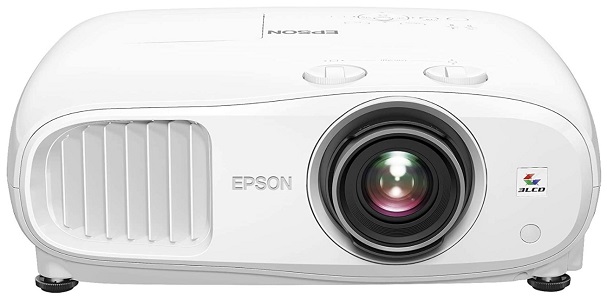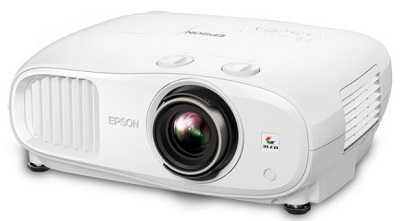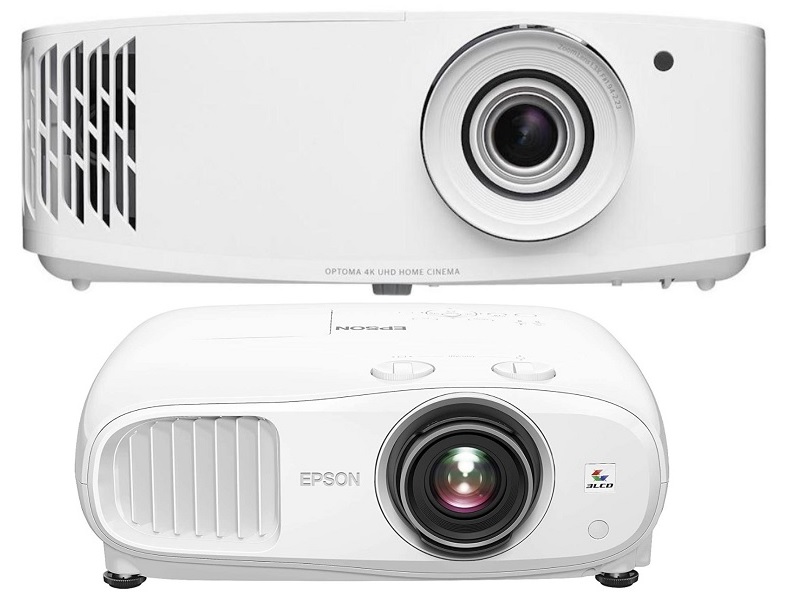Home theater projectors have come a long way. Even 4K resolution is a budget-friendly option. Along with stunning image clarity, some lower-priced 4K projectors also boast a lag time that will make avid gamers happy.
At first glance, the Optoma UHD30 vs the Epson 3800 seems similar, except for the price. The 3800 does cost a little more, but you get better audio. It’s also easier to install. The Optoma UHD30 produces a brighter picture and has a higher contrast ratio. It’s also priced a little lower.(>>> Find on Amazon)
To help you choose the best 4K projector for your home entertainment system, here’s a more in-depth look at both models.
Optoma UHD30 Vs Epson 3800 Specifications:
| Optoma UHD30 | Epson 3800 | |
|---|---|---|
 |  |
|
| Resolution | 3840x2160 | 1920x1080 4K w/pixel shifting |
| Contrast Ratio | 500,000:1 | 100,000:1 |
| Brightness (Lumens) | 3,400 ANSI | 3,000 ANSI |
| Input Lag | 16ms | 29ms |
| Throw Distance | 4.2' - 33.0' | 6.2' - 28.8' |
| Screen size | 34" - 302" | 40" - 300" |
| Internal Speakers | 5.0 Watts Mono | 10.0 Watts × 2 |
| Price | Find on Amazon | Bhphotovideo.com |
Image Quality
Both projectors have 3840×2160 resolution. You get a true 4K viewing experience. You do get a brighter picture with the UHD30. It has a 3,400 lumens rating, compared to the Epson 3800. The difference in lumens is only noticeable in ambient lighting. What you will notice is the contrast ratio.
The Optoma projector has a 500,000:1 contrast ratio. Whites are bright and crisp, while blacks are rich and have depth. The contrast ratio of 100,00:1 on the 3800 is acceptable, but there is still a noticeable difference between the two projectors.
Better Image Quality: Optoma UHD30
Gaming Quality
With 4K resolution and 100” screen images, gamers can see every detail of the level. The UHD30 and 3800 both have lag times around 16ms. Even sports and action games will run smoothly when you have the projectors set in gaming mode.
The UHD30 does have a fast refresh rate, and you don’t lose 4K resolution in gaming mode. You don’t have to worry about blurry frames or blocking on your graphic-intensive games.
Better Gaming Quality: Optoma UHD30
Ease of Installation and Set-Up
The UHD30 does have a shorter throw distance of 4.2’, while the 3800 needs at least 6.2’ to cast 100” images. Even though you need less space with the Optoma 4K projector, the Epson 3800 offers a more flexible installation and easier image alignment.
With the UHD30 you have vertical keystone correction and a 1.1x zoom. The 3800 from Epson has both horizontal and vertical digital correction, along with 1.62x zoom. It’s easier to align onscreen images without having the projector placed in front of the screen.
Easier installation: Epson 3800
Sound Quality
The audio from either projector is an improvement over your TV speakers, but you won’t get surround sound. The UHD30 comes with 5-watt internal speakers. You can clearly hear audio and music across all frequencies.
The Epson projector does come with more powerful built-in speakers at 10 watts. The bass is a little punchier and you won’t notice as much distortion when the volume is turned up.
Better Sound Quality: Epson 3800
Optoma UHD30 Review

The Optoma UHD30 produces a bright picture with accurate colors. It also has an input lag that can handle everything from action to multiple-player games without blurry images or slow frame-by-frame action.
It has a 500,000:1 contrast ratio, along with dynamic black. Colors are true to life with the 8-segmented color wheel. You see colors the way nature intended. The projector is also compatible with HLG and HDR10 technologies to ensure vivid images in almost any environment. Add in the 3,400 lumens light source, and you can use the projector any time of the day or night.
Gamers are excited over the low latency in gaming mod. They also don’t have to worry about losing image clarity in gaming mode. When you drop the resolution to lower input lag, you still get bright, clear images without color bleeding or fading. For a more detailed review of the UHD30 click here.
Pros
- 4K resolution
- Dynamic black contrast
- Low input lag
- Plenty of connections
- Flexible installation
Cons
- It’s harder to adjust onscreen images, especially when the projector is ceiling mounted
- Distortion is common when the speakers are at higher volume levels
Epson 3800 Review

The 3800 has a low input lag, around 16ms in gaming mode. The refresh rate also ensures smooth frame-by-frame action on fast action packed games. You won’t have any problems keeping up on fast-paced or action games even if there are multiple players.
The 3,000 lumens light source is enough to produce a bright picture in dim or dark lighting. You also get realistic colors, thanks to the 3LCD technology. A 100,000:1 contrast ratio ensures whites are bright and blacks inky dark. The pixel-shifting technology also gives you sharp, detailed 4K images.
With dual 10 watt speakers, surround sound isn’t possible but you won’t complain about audio quality. You’ll hear deep bass and clear audio at almost any volume level. The 3800 also comes with plenty of connections for your external devices.
Pros
- 3D support
- Flexible installation
- Low latency
- Accurate colors
- 10-watt speakers
Cons
- The pixel shifting technology doesn’t produce true 4K images
- External noise from the fan can interfere with the audio
Conclusion
It’s not easy to compare the Optoma UHD30 vs the Epson 3800. There are a lot of similarities. Both produce bright, clear images, and have an input lag of around 16ms. There are a few areas the Optoma UHD30 comes out as the winner. (>>> Check price on Amazon) You get a brighter picture with more details, even in gaming mode.
The Epson 3800 is a little easier to set up. The 10-watt speakers are also an improvement over the internal ones in the UHD30. With this being said, the Optoma UHD30 does produce a better picture both in and out of gaming mode. It also comes with a lower price tag.
